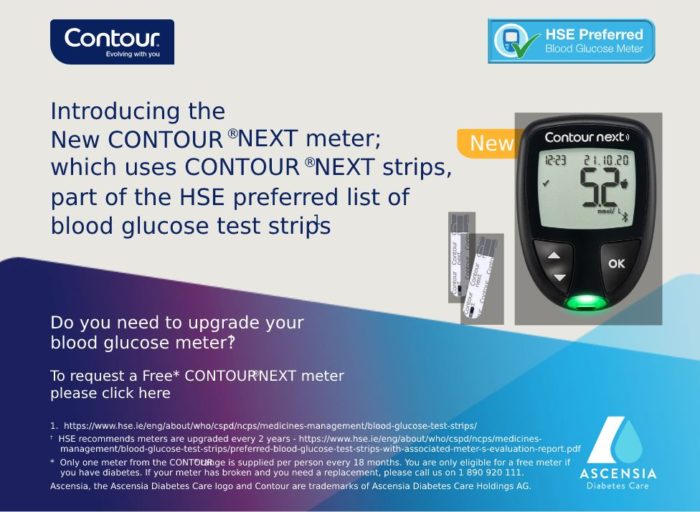The following companies support Diabetes Ireland by sponsoring events, education meetings and published educational and awareness material. They supply Meters in Ireland.
Click on these images to learn more about Specific Meters/Readers
Monitoring Blood Glucose Levels at Home
Blood glucose monitoring is an essential part of the management of Type 1 diabetes allowing you to monitor the effect of food, insulin doses and physical activity so you can make informed decisions on your diabetes management every day. Blood glucose monitoring will also help you and your diabetes team assess if your insulin is working for you.
When you are diagnosed with Diabetes your diabetes nurse will advise you how to monitor your blood glucose readings at home. You will be given a meter called a glucometer and shown how to use it, advised how often you should test your blood glucose level and what results to aim for.
A glucometer provides a one-off reading of blood glucose. You place a test strip into the device, then you prick a clean fingertip with a special needle (lancet) to get a drop of blood. You carefully touch the test strip to the blood and wait for a blood glucose reading to appear on the screen. This is a one-off reading, a moment in time.
When testing your blood glucose levels you should:
- Wash your hands before testing as any food on your hands may affect the result
- Using the lancing device prick the side of your finger to obtain a drop of blood
- Use a different finger each time so one finger doesn’t become sore
- Replace your blood testing meter every two years
- Never share your blood glucose testing equipment.
A general recommendation is to keep your blood glucose targets between 4-8mmol, but your diabetes team will help you set appropriate targets for you.
HSE preferred blood glucose meter
In January 2021 the HSE-Medicines Management Programme (MMP) has identified preferred blood glucose test strips (BGTS) with associated meters for adults with type 1 and type 2 diabetes mellitus. A summary of the preferred blood glucose testing strips is available on the following link.
Meters for those who are visually impaired
The only available talking meter for the visually impaired is the Gluco RX Nexus Voice and it is available through local pharmacies. The distributor for the meter and strips is Windzor Healthcare.
Glucose sensors
Glucose sensors are another method of monitoring the glucose levels. They are worn on the body and measure glucose in and around the bodys cells giving more of an insight into glucose level variability and patterns throughout the day and night. Glucose sensors are continuous glucose monitors or flash glucose monitors.
Glucose Sensors v’s blood glucose monitoring
Glucose sensors measure the glucose levels in the fluid that bathes and surrounds body cells (called Interstitial fluid). They do not measure glucose levels in the blood as the sensor is not placed in the blood stream. Blood glucose readings and fluid glucose readings will be close but won’t match and there will be a greater difference when glucose levels are changing more rapidly like after eating, after taking insulin and during exercise. Due to the continuous readings of glucose sensors you can see glucose patterns/trends over time and how quickly the levels are rising and falling.
When using a glucose sensor, if the symptoms experienced do not reflect the glucose readings you should verify your blood glucose level using your meter.
Continuous Glucose Monitoring (CGM)
Continuous glucose monitoring consists of a small disposable sensor (used for between 7-10 days) that is inserted by the user under the skin. The sensor measures glucose levels in and around the bodys cells. A transmitter is connected to the sensor and glucose results are wirelessly transmitted to a compatible smart device (with app) or compatible insulin pump. The sensor records a glucose reading every 5 minutes with arrows displaying the direction the glucose is travelling in and by glancing at phone/pump the user can see this information. There are alarms to warn of high and low blood glucose levels. If symptoms experienced by the user do not match the readings being displayed by the sensor it is recommended to do a finger prick blood glucose to verify the blood glucose level. CGM data can be shared with more than one smart device so other family members can be aware of your glucose levels once there is an internet connection available. Glucose data reports can be shared with your diabetes team in between appointments also.
Continuous Glucose Monitors availability in Ireland
Continuous Glucose Monitor devices are available on the long-term illness scheme but are not offered routinely to people with Type 1 diabetes in Ireland. A consultant endocrinologist may recommend them in circumstances such as, an individual not recognising their hypos symptoms, for those who have an extreme fear of hypos or those who experience hypos without symptoms that cause problems with daily activities.
Continuous glucose monitors available in Ireland
Dexcom G6 https://www.dexcom.com/en-IE
Guardian Connect https://guardianconnect.medtronic-diabetes.ie/
Flash Glucose Monitoring
A flash glucose monitoring system consists of a small disposable glucose sensor worn on the skin for up to 14 days and a wireless reader device/smartphone with app. The user must physically scan the sensor using the reader device/smartphone with app to see their real time glucose readings displayed on the screen, and a trend arrow showing the direction that the glucose level is going. As the data is not being continuously sent to the reader device it does not have any alarm settings. The system does not replace blood glucose monitoring using the meter and finger prick. A blood glucose reading will need to be confirmed with a finger prick during times of rapidly changing glucose levels, impending hypoglycaemia or if the symptoms experienced don’t match the readings displayed on the reader. Glucose data can be shared with more than one smart device so other family members can be aware of your glucose levels once there is an internet connection available. Glucose data reports can be shared with your diabetes team in between appointments also.
Flash glucose monitoring is free for children and young adults between the ages of 4-21 with Type 1 diabetes. It is also available to buy privately and one can claim TAX and VAT back on its cost. For more information on flash glucose monitoring speak to your diabetes team or see https://freestylediabetes.ie/freestyle-libre
The History of Diabetes Technology





